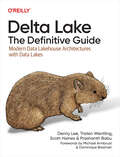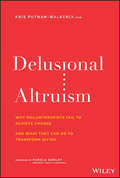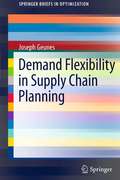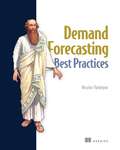- Table View
- List View
Deloitte & Touche (A): A Hole in the Pipeline
by Rosabeth Moss Kanter Jane RoessnerDeloitte & Touche was losing talented women, and CEO Mike Cook wanted to stop the loss, especially as the accounting and consulting fields became more competitive. The firm commissioned an analysis of the situation; now it had to consider the results and develop a plan change.
Deloitte & Touche (B): Changing the Workplace
by Rosabeth Moss Kanter Jane RoessnerDeloitte & Touche women's initiative changed the workplace culture at the firm, solved retention problems, and brought external benefits. Now a new CEO must decide how to take this a step further as competition for talent was even stronger, young people had different needs and aspirations, and the firm's global offices had not yet embraced this U.S. initiative.
Deloitte & Touche Consulting Group
by David M. Upton Christine SteinmanExamines two dilemmas often faced by an operations consultant. First, the dual responsibility to both client and consulting firm. Second, the management of the often competing pressure to deliver immediate results, at the same time laying the foundation for long-term performance improvement.
Deloitte's Pixel (A): Consulting with Open Talent
by Michael L. Tushman John Winsor Kerry HermanDeloitte Consulting's General Manager Balaji Bondili, head of Pixel, considers how best to grow Deloitte Consulting's use of open (on-demand) talent, as consulting companies and their clients face transformative change in the way client engagements and projects get done. Pixel, started in 2014, helps facilitate open (or on-demand) talent and crowdsourcing for Deloitte Consulting client engagements, to access specific, difficult-to-find expertise, collaborate to develop new products and/or insights, and to design, build, and test new digital assets. Bondili has found some avid users-and evangelists-of Pixel's services among Deloitte Consulting's principals, however uptake across the broader organization has been slow, and in some pockets has met with deep resistance.
Delphi Corp. and the Credit Derivatives Market (A)
by Stuart C. Gilson Sarah L. Abbott Victoria IvashinaIn 2005 Jane Bauer-Martin, a hedge fund manager, is considering what she should do with the fund's large investment in the publicly traded bonds of Delphi Corp., a financially troubled auto parts supplier. Delphi is General Motor's key auto parts supplier, and, like GM, it is burdened with large pension and other retiree liabilities that threaten to push it into bankruptcy. Bauer-Martin is considering using various credit derivatives (credit default swaps, credit-linked notes, credit default swap indices, total return swaps, etc.) to hedge her position in Delphi debt, or to speculate on future Delphi bond prices.
Delta Air Lines (A): The Low-Cost Carrier Threat
by Jan W. Rivkin Laurent TherivelIn the 'Delta Air Lines (A): The Low-Cost Carrier Threat' case, the top management of Delta Air Lines must decide how to respond to the threat posed by low-cost carriers such as Southwest and JetBlue. Among the options considered is the launch of a low-cost subsidiary by Delta itself. Prior efforts to launch a low-cost subsidiary, by Delta and by other full-service airlines, have failed. Can Delta devise a better response?
Delta Blues: U.S.-Vietnam Catfish Trade Dispute (A)
by Regina AbramiExamines the growing tensions between strategies of national development and the rules of international business. At issue is how increasing globalization is changing the rules of national development for both developing and developed countries. The comparative focus on aquaculture, and the catfish industry in particular, also offers a window into a growing international industry and its potential as a source of poverty alleviation around the globe. Also discusses the U.S. antidumping policy and its processes of investigation.
Delta Blues: U.S.-Vietnam Catfish Trade Dispute (B)
by Regina Abrami Alan W. TuAn abstract is not available for this product.
Delta Empire: Lee Wilson and the Transformation of Agriculture in the New South (Making the Modern South)
by Jeannie WhayneIn Delta Empire: Lee Wilson and the Transformation of Agriculture in the New South Jeannie Whayne employs the fascinating history of a powerful plantation owner in the Arkansas delta to recount the evolution of southern agriculture from the late nineteenth century through World War II. After his father's death in 1870, Robert E. "Lee" Wilson inherited 400 acres of land in Mississippi County, Arkansas. Over his lifetime, he transformed that inheritance into a 50,000-acre lumber operation and cotton plantation. Early on, Wilson saw an opportunity in the swampy local terrain, which sold for as little as fifty cents an acre, to satisfy an expanding national market for Arkansas forest reserves. He also led the fundamental transformation of the landscape, involving the drainage of tens of thousands of acres of land, in order to create the vast agricultural empire he envisioned. A consummate manager, Wilson employed the tenancy and sharecropping system to his advantage while earning a reputation for fair treatment of laborers, a reputation -- Whayne suggests -- not entirely deserved. He cultivated a cadre of relatives and employees from whom he expected absolute devotion. Leveraging every asset during his life and often deeply in debt, Wilson saved his company from bankruptcy several times, leaving it to the next generation to successfully steer the business through the challenges of the 1930s and World War II. Delta Empire traces the transition from the labor-intensive sharecropping and tenancy system to the capital-intensive neo-plantations of the post--World War II era to the portfolio plantation model. Through Wilson's story Whayne provides a compelling case study of strategic innovation and the changing economy of the South in the late nineteenth century.
Delta Lake: Modern Data Lakehouse Architectures with Data Lakes
by Denny Lee Scott Haines Tristen Wentling Prashanth BabuReady to simplify the process of building data lakehouses and data pipelines at scale? In this practical guide, learn how Delta Lake is helping data engineers, data scientists, and data analysts overcome key data reliability challenges with modern data engineering and management techniques.Authors Denny Lee, Tristen Wentling, Scott Haines, and Prashanth Babu (with contributions from Delta Lake maintainer R. Tyler Croy) share expert insights on all things Delta Lake--including how to run batch and streaming jobs concurrently and accelerate the usability of your data. You'll also uncover how ACID transactions bring reliability to data lakehouses at scale.This book helps you:Understand key data reliability challenges and how Delta Lake solves themExplain the critical role of Delta transaction logs as a single source of truthLearn the Delta Lake ecosystem with technologies like Apache Flink, Kafka, and TrinoArchitect data lakehouses with the medallion architectureOptimize Delta Lake performance with features like deletion vectors and liquid clustering
Deltas in the Anthropocene
by W. Neil Adger Robert J. Nicholls Craig W. Hutton Susan E. HansonThe Anthropocene is the human-dominated modern era that has accelerated social, environmental and climate change across the world in the last few decades. This open access book examines the challenges the Anthropocene presents to the sustainable management of deltas, both the many threats as well as the opportunities. In the world’s deltas the Anthropocene is manifest in major land use change, the damming of rivers, the engineering of coasts and the growth of some of the world’s largest megacities; deltas are home to one in twelve of all people in the world. The book explores bio-physical and social dynamics and makes clear adaptation choices and trade-offs that underpin policy and governance processes, including visionary delta management plans. It details new analysis to illustrate these challenges, based on three significant and contrasting deltas: the Ganges-Brahmaputra-Meghna, Mahanadi and Volta. This multi-disciplinary, policy-orientated volume is strongly aligned to the United Nation’s Sustainable Development Goals as delta populations often experience extremes of poverty, gender and structural inequality, variable levels of health and well-being, while being vulnerable to extreme and systematic climate change.
Delusional Altruism: Why Philanthropists Fail To Achieve Change and What They Can Do To Transform Giving
by Kris Putnam-WalkerlyHow you give matters. Discover philanthropic strategies for creating transformational change. Whether you regularly donate to charity, run a small family foundation, or are responsible for millions of dollars in grants, you are a philanthropist. Delusional Altruism: Why Philanthropists Fail To Achieve Change and What They Can Do To Transform Giving looks at how you can create transformational change. It reminds us that how we give is as important as the amount we give. The author describes common practices that hinder transformational change and explains how to avoid them, ensuring that your gifts help create the impact you seek. Delusional Altruism—a set of all-too-common errors in philanthropic strategy—can derail a program of giving and result in a loss of efficiency and effectiveness. This book asks philanthropists and charitable organizations to consider whether they have fallen under the spell of Delusional Altruism. Are you cutting out impactful giving in order to save money or avoid uncertainty? Is your philanthropic approach unnecessarily restricted by traditional thinking? This book will help you answer these questions and determine how you can achieve better outcomes through the process of Transformational Giving. Ask questions that spur learning and fuel innovation Believe that investment in yourself and your operation is important Increase the speed of your actions to increase the impact of your giving Give in ways that create lasting, sustainable change Follow strategies to make your philanthropy unstoppable Although enhanced opportunities for philanthropic giving are on the horizon, changes to philanthropic practice are needed to prevent this philanthropy boom from becoming under-leveraged. Implementing updated approaches now can lead to positive change for the future. Read Delusional Altruism to learn how you can transform reality with strategic giving.
Delusions of Competence: The Near-Death of Lloyd’s of London 1970--2002 (Palgrave Studies in Economic History)
by Robin PearsonThis book examines the crisis at the famous insurance market, Lloyd's of London, during the late twentieth century, which nearly destroyed the 300-year-old institution. While rapid structural change resulting from system collapse is less common in insurance than in the history of other financial services, one exception was the Lloyd’s crisis. Hitherto, explanations of the crisis have focused on the effects of catastrophic losses and poor governance. By drawing on contemporary accounts of the crisis, the author constructs the first comprehensive scholarly analysis of the public and political response. The book applies theoretical concepts from behavioural economics and economic psychology to argue that multiple delusions of competence were at work both within and outside the Lloyd’s market. Arrogance, elitism and defence of vested interests comprised endogenous elements of the crisis. Entrenched ideas about the virtues of self-regulation and faith in insider experts also played a role. The result was a misdiagnosis by both insiders and politicians of what ailed Lloyd’s and a series of reforms that failed to address the underlying causes of its disease. This book offers a salutary lesson from recent history about the importance of the transparency, accountability and effective monitoring of financial institutions. It is of interest to academics and students of economic and financial history, business, insurance, political economy and history.
Delwarca Software Remote Support Unit
by Roy D. Shapiro Paul E. MorrisonDelwarca Software provides business software to large corporate clients around the world. The firm serves customers who prefer to assemble corporate solutions using a combination of software programs from various suppliers rather than implementing a single enterprise resource planning system. Consequently, Delwarca must provide telephone support services for complex software-hardware interaction and performance problems in addition to the typical software support issues around software installation and upgrades, malware attacks, and processing failures. The manager of the remote support unit implemented a new triage program for customer calls hoping to reduce customer wait time, improve customer satisfaction, and reduce costs. After one year, customer dissatisfaction is at an all-time high and he must perform a quantitative analysis of the current process, considering wait times for customers as well as cost per call, before making a final recommendation. This case can be used in a first-year MBA course in Service Management or Operations Management or a course in industrial engineering. It can also be used to introduce simple queuing theory.
Demand
by Karl Weber Adrian SlywotzkyIn DEMAND: Giving People What They Love Before They Know They Want It (Crown Business; October 2011), Adrian Slywotzky, named by Industry Week one of the world's six most influential management thinkers, provides a radically new way to think about demand, with a big idea and a host of practical applications--not just for people in business but also for social activists, governments leaders, non-profit managers, and other would-be innovators. They all need to master such ground-breaking concepts as the hassle map (and the secrets of fixing it); the curse of the incomplete product (and how to avoid it); why very good != magnetic; how what you don't see can make or break a product; the art of transforming fence sitters into customers; why there's no such thing as an average customer; and why real demand comes from a 45-degree angle of improvement (rather than the five degrees most organizations manage).From the Hardcover edition.
Demand Better Results - and Get Them (Classic)
by Robert H. SchafferThis article, first published in 1974, answers one of management's most important questions: Why do so few organizations reach their productivity potential? The author answers that most executives fail to establish expectations of performance improvement in ways that get results. To set high goals that employees respond to and are accountable for, managers must invest their own time and energy. The first step is to set a modest, measurable goal concerning an important organizational problem. If this goal is met, management uses the success as a springboard for more ambitious demands.
Demand Driven Strategic Planning
by Marcos Fava NevesThis book offers students and practitioners alike an integrated approach to strategic planning for companies. Marcos Fava Neves presents a new and unique perspective on this critical topic based on three main points: strongly demand-driven decisions that bridge the gap between long- and short-term strategy; a vision of a company as an integrated network, full of relationships that deserve consideration during the planning process; and the introduction of ‘collective-action’ thinking, which raises the prospect for cooperation between competitors. With this clear, comprehensive framework for strategic planning, companies can be sure to navigate today’s complex environment and enhance their prospects of success.
Demand Driven Supply Chain: A Structured and Practical Roadmap to Increase Profitability
by Paulo MendesThis book aims to identify and describe the practical key components of demand driven supply chains, and based on these components, develops a structured and integrated assessment framework that companies can use to assess their current and desired future supply chain states in light of the Demand Driven Supply Chain (DDSC) concepts. Another contribution of the book is the structured framework developed to design a supply chain strategy, which will consider the DDSC assessment results as one of the key inputs, and will support the implementation of the opportunities identified during the assessment. The framework presented in this book was applied in different supply chain operations of a global CPG company to validate the methodology and formalize an action plan to allow these operations move towards a DDSC. Results show clear opportunities to improve supply chain operation and become more demand driven.
Demand Flexibility in Supply Chain Planning
by Joseph GeunesThis work encapsulates the essential developments in this field into a single resource, as well as to set an agenda for further development in the field. This brief focuses on the demand flexibility in supply chains with fragmented results distributed throughout the literature. These results have strong implications for managing real-world complex operations planning problems. This book exploits dimensions of demand flexibility in supply chains and characterizes the best fit between demand properties and operations capabilities and constraints. The origins and seminal works are traced in integrated demand and operations planning and an in-depth documentation is provided for the current state of the art. Systems with inherent costs and constraints that must respond to some set of demands at a minimum cost are examined. Crucial unanswered questions are explored and the high-value research directions are highlighted for both practice and for the development of new and interesting optimization models and algorithms.
Demand Forecasting Best Practices
by Nicolas VandeputLead your demand planning process to excellence and deliver real value to your supply chain.In Demand Forecasting Best Practices you&’ll learn how to: Lead your team to improve quality while reducing workload Properly define the objectives and granularity of your demand planning Use intelligent KPIs to track accuracy and bias Identify areas for process improvement Help planners and stakeholders add value Determine relevant data to collect and how best to collect it Utilize different statistical and machine learning models An expert demand forecaster can help an organization avoid overproduction, reduce waste, and optimize inventory levels for a real competitive advantage. Demand Forecasting Best Practices teaches you how to become that virtuoso demand forecaster. This one-of-a-kind guide reveals forecasting tools, metrics, models, and stakeholder management techniques for delivering more effective supply chains. Everything you learn has been proven and tested in a live business environment. Discover author Nicolas Vandeput&’s original five step framework for demand planning excellence and learn how to tailor it to your own company&’s needs. Illustrations and real-world examples make each concept easy to understand and easy to follow. You&’ll soon be delivering accurate predictions that are driving major business value. About the Technology An expert demand forecaster can help an organization avoid overproduction, reduce waste, and optimize inventory levels for a real competitive advantage. This book teaches you how to become that virtuoso demand forecaster. About the Book Demand Forecasting Best Practices reveals forecasting tools, metrics, models, and stakeholder management techniques for managing your demand planning process efficiently and effectively. Everything you learn has been proven and tested in a live business environment. Discover author Nicolas Vandeput&’s original five step framework for demand planning excellence and learn how to tailor it to your own company&’s needs. Illustrations and real-world examples make each concept easy to understand and easy to follow. You&’ll soon be delivering accurate predictions that are driving major business value. What's Inside Enhance forecasting quality while reducing team workload Utilize intelligent KPIs to track accuracy and bias Identify process areas for improvement Assist stakeholders in sales, marketing, and finance Optimize statistical and machine learning models About the Reader For demand planners, sales and operations managers, supply chain leaders, and data scientists. About the Author Nicolas Vandeput is a supply chain data scientist, the founder of consultancy company SupChains in 2016, and a teacher at CentraleSupélec, France. Table of Contents: Part 1 - Forecasting demand 1 Demand forecasting excellence 2 Introduction to demand forecasting 3 Capturing unconstrained demand (and not sales) 4 Collaboration: data sharing and planning alignment 5 Forecasting hierarchies 6 How long should the forecasting horizon be? 7 Should we reconcile forecasts to align supply chains? Part 2 - Measuring forecasting quality 8 Forecasting metrics 9 Choosing the best forecasting KPI 10 What is a good forecast error? 11 Measuring forecasting accuracy on a product portfolio Part 3 - Data-driven forecasting process 12 Forecast value added 13 What do you review? ABC XYZ segmentations and other methods Part 4 - Forecasting methods 14 Statistical forecasting 15 Machine learning 16 Judgmental forecasting 17 Now it&’s your turn!
Demand Forecasting for Inventory Control
by Nick T. ThomopoulosThis book describes the methods used to forecast the demands at inventory holding locations. The methods are proven, practical and doable for most applications, and pertain to demand patterns that are horizontal, trending, seasonal, promotion and multi-sku. The forecasting methods include regression, moving averages, discounting, smoothing, two-stage forecasts, dampening forecasts, advance demand forecasts, initial forecasts, all time forecasts, top-down, bottom-up, raw and integer forecasts, Also described are demand history, demand profile, forecast error, coefficient of variation, forecast sensitivity and filtering outliers. The book shows how the forecasts with the standard normal, partial normal and truncated normal distributions are used to generate the safety stock for the availability and the percent fill customer service methods. The material presents topics that people want and should know in the work place. The presentation is easy to read for students and practitioners; there is little need to delve into difficult mathematical relationships, and numerical examples are presented throughout to guide the reader on applications. Practitioners will be able to apply the methods learned to the systems in their locations, and the typical worker will want the book on their bookshelf for reference. The potential market is vast. It includes everyone in professional organizations like APICS, DSI and INFORMS; MBA graduates, people in industry, and students in management science, business and industrial engineering.
Demand Management: Stagflation - Volume 2 (Routledge Revivals: Stagflation #Vol. 02)
by David A Vines J. M. Maciejowski J. E. MeadeFirst published in 1983, this is the second of two volumes on the causes and cure of stagflation – that combination of mass unemployment and rapid inflation that is currently afflicting the mixed economies of the industrially developed world. The authors deplore the unemployment due to the failure of governments to adopt Keynesian measures for the expansion of economic activity, but recognise that in present conditions such measures would lead to an unacceptable and explosive inflation of money wages and prices. They therefore advocate a dual strategy of financial policies for a steady expansion of total money incomes combined with individual wage rates set at levels to promote employment. The book is of importance for all those concerned with macroeconomic theory and policy. The description of the meaning of a New Keynesian policy and of the arguments for it have been written in a way which should be intelligible to policy-makers and students, and not only to economists with technical training. Professional macroeconomists will be interested not only in these sections but also in the fully specified macroeconomic model used to analyse New Keynesian policies in economic terms and to carry out a counterfactual re-running of history. In addition, the unusually detailed exposition of the application of control techniques to a difficult multivariable control problem also makes the book of interest to control engineers who wish to acquaint themselves with recent generalisations of classical frequency response methods.












